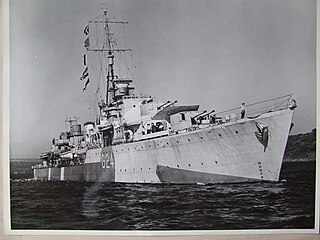Related Research Articles

HMCS Haida is a Tribal-class destroyer that served in the Royal Canadian Navy (RCN) from 1943 to 1963, participating in World War II and the Korean War. She was named for the Haida people.
Several Canadian naval ships have been named HMCS Athabaskan. All named for the Athabaskan people and destroyers. First ship was British built, the other two in Canada.

HMCS Athabaskan was the first of three destroyers of the Royal Canadian Navy to bear this name. It was a destroyer of the Tribal class, that served in the Second World War. She was named for the First Nations peoples who make up the Athabaskan language group. She was torpedoed in the English Channel and sunk in 1944.

The Tribal class, or Afridi class, were a class of destroyers built for the Royal Navy, Royal Canadian Navy and Royal Australian Navy that saw service in World War II. Originally conceived during design studies for a light fleet cruiser, the Tribals evolved into fast, powerful destroyers, with greater emphasis on guns over torpedoes than previous destroyers, in response to new designs by Japan, Italy, and Germany. The Tribals were well admired by their crews and the public when they were in service due to their power, often becoming symbols of prestige while in service.
At least six vessels of the British Royal Navy have been named HMS Decoy.
Several Canadian naval units have been named HMCS Nootka.
USS Haraden may refer to the following ships of the United States Navy:
Four Canadian naval units have been named HMCS Ottawa.

HMCS Huron was an Iroquois-class destroyer that served with the Canadian Forces from 16 December 1972 to 23 October 2000. It served mainly on the western coast of Canada. After decommissioning, its hull was stripped to be used in a live-fire exercise. The ship's hulk was eventually sunk by gunfire from its twin ship, HMCS Algonquin. Huron was the second ship of its class and the second vessel to use the designation HMCS Huron.
Several Canadian naval units have been named HMCS Iroquois.

HMCS Huron was a Tribal-class destroyer that served in the Royal Canadian Navy in the Second World War and the Korean War. She was the first ship to bear this name, entering service in 1943. She was named for the Huron people. During the Second World War the vessel saw service in Operation Neptune in the Bay of Biscay and along the French coast in support of the invasion of Normandy and escorted convoys to the Soviet Union. Following the war, the ship was placed in reserve. The destroyer was activated in 1950 as a training ship, but with the onset of the Korean War, was modernized and deployed twice to Korea. Following the war, Huron reverted to a training ship and took part in Cold War-era North Atlantic Treaty Organization (NATO) naval exercises until being paid off for the final time in 1963 and broken up for scrap in 1965.

Vice Admiral Henry George DeWolf was a Canadian naval officer who was famous as the first commander of HMCS Haida during the Second World War.
Several Canadian naval units have been named HMCS Kootenay.
Four ships of the Royal Navy have borne the name HMS Kempenfelt, after rear-admiral Richard Kempenfelt:
Several Canadian naval units have been named HMCS Restigouche.
Several Canadian naval units have been named HMCS Gatineau.
Several Canadian naval units have been named HMCS Saskatchewan.

The Battle of Ushant, also known as the Battle of Brittany, occurred on the early morning of 9 June 1944 and was an engagement between German and Allied destroyer flotillas off the coast of Brittany. The action came shortly after the initial Allied landings in Normandy. After a confused engagement during the night the Allies sank one of the German destroyers and forced another ashore, where she was wrecked.
The action of 26 April 1944 occurred as a part of Operation Tunnel, Allied destroyer sweeps of the coast of Brittany in preparation for Operation Overlord. On the night of 25–26 April, a sweep was conducted by the Dido-class cruiser HMS Black Prince and the Tribal-class destroyers HMS Ashanti, HMCS Athabaskan, HMCS Haida and HMCS Huron. They engaged the Elbing-class torpedo boats T24, T27 and T29 off the île de Batz until T29 was destroyed. Both of the other torpedo boats were damaged in the engagement. T29 caused some casualties on Haida and Huron before sinking with a loss of 135 men. Haida and Ashanti collided with each other near the end of the action.
HMS Pasley (K564), ex-Lindsay, was a Captain-class frigate of the Evarts-class of destroyer escort, originally commissioned to be built for the United States Navy. Before she was finished in 1943, she was transferred to the Royal Navy under the terms of Lend-Lease, and saw service during the World War II from 1943 to 1945. She was the third ship of the Royal Navy to be named Pasley, after Admiral Sir Thomas Pasley (1734-1808), who commanded aboard his flagship HMS Bellerophon at the Glorious First of June in 1794.
References
Directorate of History and Heritage - HMCS Huron Archived 2012-03-04 at the Wayback Machine